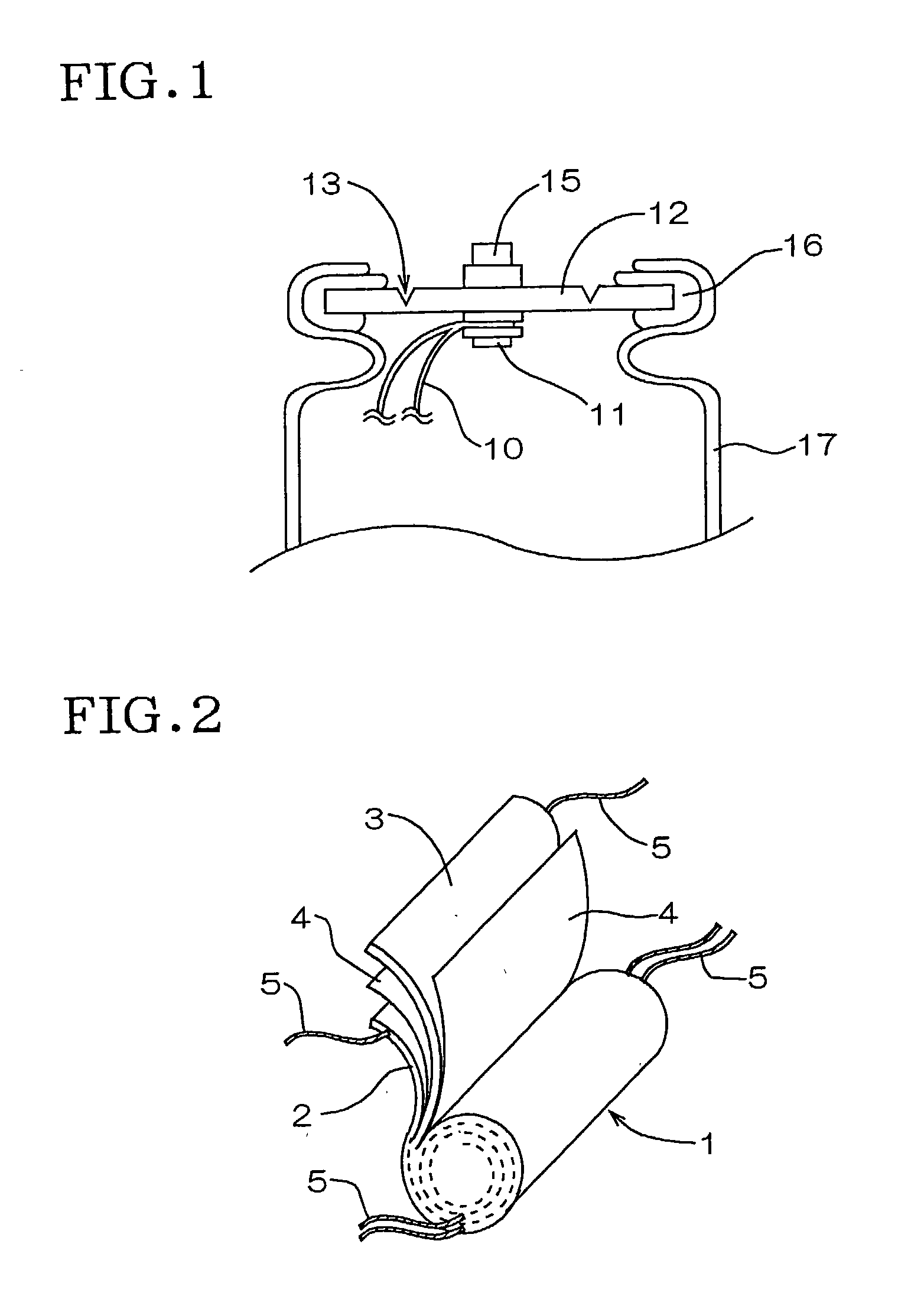Lithium secondary battery for use in electric vehicle
a secondary battery and electric vehicle technology, applied in the direction of secondary cell servicing/maintenance, cell components, cell component details, etc., can solve the problems of battery reducing the space utility of the vehicle, complex internal structure of the lamination type battery, and no clear idea on how to achieve the above concept using parameters
- Summary
- Abstract
- Description
- Claims
- Application Information
AI Technical Summary
Benefits of technology
Problems solved by technology
Method used
Image
Examples
example 1
[0064] A positive electrode active material (LiMn.sub.2O.sub.4) and a carbon powder (acetylene black) (this powder was for allowing the active material to have a higher conductivity) were mixed, and the resulting mixture was coated on an aluminum foil to produce a positive electrode having an electrode surface shape of 3,400 mm in length of winding direction and 200 mm in width. Separately, a highly graphitized carbon material (a fibrous powder) was coated on a copper foil to produce a negative electrode of 3,600 mm in length of winding direction and 200 mm in width. The positive electrode and the negative electrode were wound using, between them, a separator (an insulator) of 4,000 mm in length and 220 mm in width obtained by sandwiching a microporous polyethylene film capable of transmitting lithium ion with two same porous polypropylene films capable of transmitting lithium ion to form a three-layered structure, whereby an electricity-generating body was produced.
[0065] The elect...
example 2
[0075] A positive electrode active material [Li-rich lithium manganese oxide, Li(Li.sub.xMn.sub.2-x)O.sub.4 (x=0.05)] and a carbon powder (acetylene black) (this powder was for allowing the active material to have a higher conductivity) were mixed, and the resulting mixture was coated on an aluminum foil to produce a positive electrode having an electrode surface shape of 3,600 mm in length of winding direction and 100 mm in width. Separately, a highly graphitized carbon material (a fibrous powder) was coated on a copper foil to produce a negative electrode of 4,000 mm in length of winding direction and 100 mm in width. The positive electrode and the negative electrode were wound using, between them, a separator (an insulator) of 4,500 mm in length and 120 mm in width obtained by sandwiching a microporous polyethylene film capable of transmitting lithium ion with two same porous polypropylene films capable of transmitting lithium ion to form a three-layered structure, whereby an ele...
example 3
[0084] A positive electrode active material [Li-rich lithium manganese oxide, Li(Li.sub.xMn.sub.2-x)O.sub.4 (x=0.05)] and a carbon powder (acetylene black) (this powder was for allowing the active material to have a higher conductivity) were mixed, and the resulting mixture was coated on an aluminum foil to produce a positive electrode having an electrode surface shape of 5,600 mm in length of winding direction and 50 mm in width. Separately, a highly graphitized carbon material (a fibrous powder) was coated on a copper foil to produce a negative electrode of 6,000 mm in length of winding direction and 50 mm in width. The positive electrode and the negative electrode were wound using, between them, a separator (an insulator) of 6,500 mm in length and 70 mm in width obtained by sandwiching a microporous polyethylene film capable of transmitting lithium ion with two same porous polypropylene films capable of transmitting lithium ion to form a three-layered structure, whereby an electr...
PUM
| Property | Measurement | Unit |
|---|---|---|
| terminal voltage | aaaaa | aaaaa |
| weight | aaaaa | aaaaa |
| weight | aaaaa | aaaaa |
Abstract
Description
Claims
Application Information
 Login to View More
Login to View More - R&D
- Intellectual Property
- Life Sciences
- Materials
- Tech Scout
- Unparalleled Data Quality
- Higher Quality Content
- 60% Fewer Hallucinations
Browse by: Latest US Patents, China's latest patents, Technical Efficacy Thesaurus, Application Domain, Technology Topic, Popular Technical Reports.
© 2025 PatSnap. All rights reserved.Legal|Privacy policy|Modern Slavery Act Transparency Statement|Sitemap|About US| Contact US: help@patsnap.com


